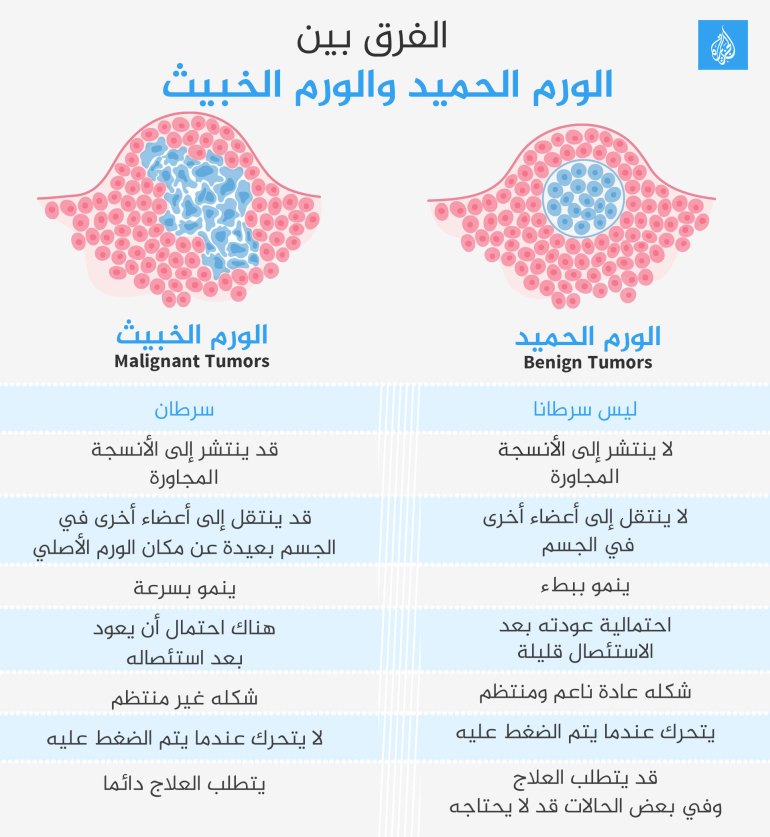How do we distinguish benign tumors from malignant tumors? What is the difference between a benign breast lump and cancer? | Health

Tumors are common health problems and are divided into two types: benign tumors and malignant tumors. The latter is what we call cancer. How do they differ in terms of symptoms and treatment?
What is a tumor?
A tumor is a group of cells that forms an abnormal mass of tissue. If you are diagnosed with a tumor, your doctor will first determine whether it is benign or malignant.
What are benign tumors?
Polyps are not cancerous and are not usually life-threatening. But like their cousins, malignant tumors form when cells grow abnormally and can form anywhere in the body.
Benign tumors do not invade adjacent tissues or spread to distant organs in the body, which is the main difference from malignant tumors.
A benign tumor does not mean it is a “good” tumor, as its transformed and dysfunctional cells can cause pain and disfigurement and can sometimes be painful or even dangerous.
However, benign tumors do not pose the same threat as malignant tumors.
What is malignant tumor?
Malignancy, or cancer, is an abnormal growth of cells that has the ability to spread into nearby tissues and metastasize to distant organs.
Malignant tumor cells have the ability to spread and metastasize, and grow faster.
What is the difference between benign tumors and malignant tumors?
The table below shows the most important differences between benign and malignant tumors.

How do I know if a tumor is benign or malignant?
Although there are differences in symptoms between benign and malignant tumors, the only way to know for sure is to have a biopsy.
A biopsy is a medical procedure in which doctors remove a small sample of tissue from a tumor and send the sample to a laboratory for testing.
A pathologist analyzes the sample under a microscope to determine whether the tissue is benign or malignant. Experts also work to characterize tumors to help guide treatment decisions.
What are the symptoms of benign tumors?
Many benign tumors cause no symptoms at all. But if it grows large enough and puts pressure on nearby tissue, it can cause the following symptoms:
- bleeding.
- Headache.
- Seizures.
- Difficulty seeing (eg, benign brain tumors).
- Anorexia.
- lose weight.
- Pain or discomfort in the affected part of the body.
- Difficulty breathing.
- In the skin, benign tumors are usually round in shape with smooth, even edges.
Do benign tumors require chemotherapy?
In many cases, adenomas do not require treatment. Your doctor may monitor it to make sure it’s not causing any problems.
But if symptoms develop, or if there’s pressure on nearby organs, such as the lungs, treatment may be needed.
Surgery is usually used to remove benign tumors, and treatment may also include chemotherapy and radiation.
The difference between benign and malignant breast tumors
Cancerous lumps in the breast are usually hard, rock-like, and regular in shape. They can be mobile (i.e. move when pressed), but are usually fixed, meaning women feel as if they are attached to the skin or nearby tissue.
There are also signs of breast malignancy:
- The skin is dimpled and has the texture of an orange peel.
- Nipple retraction, where the nipple turns inwards rather than outwards.
- Swollen lymph nodes in the armpit.
In contrast to malignant breast tumors, benign masses are usually spongy. It may look like a soft rubber ball with sharp edges. They often move easily when stressed and can be soft.
However, determining whether a breast tumor is malignant or benign requires tests such as a mammogram, and a doctor’s final decision on the type of tumor.
Do benign tumors hurt?
Benign tumors may cause pain.
Types of benign tumors
Common types of benign tumors include:
1-“Adenoma”
They usually form on the surface of the digestive tract.
2- “Fibroids”
It can appear in any organ. Fibroids are named after where they form in the body, such as uterine fibroids.
3- “Desmoid Tumor”
They are often more aggressive than most benign tumors and may invade nearby tissues and organs. But it didn’t spread.
4-“Hamartoma”
These tumors may occur in the lungs, heart, skin, brain, or breasts.
5-“Hemangioma”
These tumors are collections of blood vessel cells in the skin or internal organs. It may appear as a birthmark-like discoloration on the skin and usually disappears on its own.
6-“Lipomas”
Smooth, round lipomas are commonly found on the neck or shoulders.
7-“Leiomyoma”
This is a common gynecological tumor that occurs in the uterus.
8-“Papilloma”
These tumors grow from tissue in the skin and lining of organs.
Types of malignant tumors
1-“Cancer”
These are the most common types of malignancies. It develops in epithelial cells, the cells that line the inner surface of the body. Cancerous tumors include different types, including adenocarcinoma, basal cell carcinoma, and squamous cell carcinoma.
2-“sarcoma”
These malignant tumors form in bone, soft tissue, and other tissues, including tendons, ligaments, fat, and muscle.
3- “Germ Cell Tumors”
These tumors start in the cells that produce eggs or sperm. It most commonly occurs in the ovaries or testicles, but can also occur in the abdomen, brain, or chest.
4-“blastoma”
Blastomas form in embryonic tissue and developing cells in the eye, brain, or nervous system.
Source link





